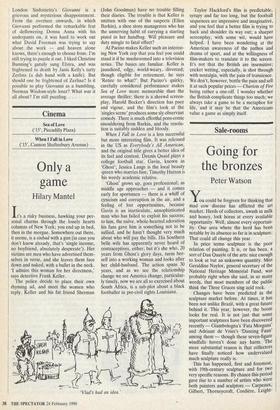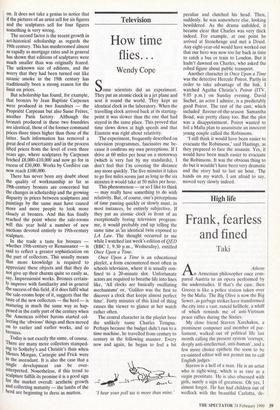Sale-rooms
Going for the bronzes
Peter Watson
Yu could be forgiven for thinking that mad cow disease has afflicted the art market. Herds of collectors, awash in milk and honey, lock horns at every available opportunity. Well, almost every opportun- ity. One area where the herd has been notable by its absence so far is in sculpture. That could all change this year.
In price terms sculpture is the poor relation of painting. It is, or has been, a sort of Dan Quayle of the arts: nice enough to look at but an unknown quantity. Miss Geraldine Naylor, general secretary of the National Heritage Memorial Fund, was probably right when she said, in so many words, that most members of the public think the Three Graces sing acid rock. Changes have been predicted in the sculpture market before. At times, it has been not unlike Brazil, with a great future behind it. This year, however, the boom looks for real. It is not just that some important sculptures have been discovered recently — Giambologna's Tata Morgana' and Adriaan de Vries's 'Dancing Faun' among them — though these seven-figure windfalls haven't done •any harm. The more substantial reason is that collectors have finally noticed how undervalued much sculpture really is. This has happened, first and foremost, with 19th-century sculpture and for tWO very specific reasons. By chance this period gave rise to a number of artists who were both painters and sculptors — Carpeaux, Gilbert, Thorneycroft, Cordiere, Leight- on. It does not take a genius to notice that if the pictures of an artist sell for six figures and the sculptures sell for four figures something is very wrong.
The second factor is the recent growth in art-historical scholarship as regards the 19th century. This has mushroomed almost as rapidly as mortgage rates and in general has shown that editions of sculptures were much smaller than was originally feared. The unknown size of editions, and the worry that they had been turned out like satanic smoke in the 19th century has traditionally been a strong reason for the limit on prices.
But scholarship has found, for example, that bronzes by Jean Baptiste Carpeaux were produced in two foundries — the Propriete Carpeaux but also Susse Freres, another Paris factory. Although the bronze's produced in these two foundries are identical, those of the former command prices three times higher than those of the latter. Such information has removed a great deal of uncertainty and in the process lifted prices from the level of even three years ago, where sculptures by Carpeaux fetched £8,000-£10,000 and now go for in excess of £30,000. Works by Cordiere can now reach £100,000.
There has never been any doubt About the quality of workmanship so far as 19th-century bronzes are concerned but the changes in scholarship and the growing disparity in prices between sculptures and Paintings by the same man have caused more and more people to look more Closely at bronzes. And this has finally reached the point where the sale-rooms Will this year hold a number of new auctions devoted entirely to 19th-century sculpture.
In the trade a taste for bronzes — Whether 19th-century or Renaissance — is said to reflect a greater sophistication on the part of collectors. This usually means that more knowledge is required to appreciate these objects and that they do not give up their charms quite so easily as, say, Impressionist works. Bronzes certain- ly improve with familiarity and in general the success of this field, if it does fulfil what the sale-rooms hope of it, suggests that the taste of the new collectors — the herd — is maturing in much the same way as hap- pened in the early part of the century when the American robber barons started col- lecting the 'obvious' things and then moved on to earlier and earlier works, and to bronzes.
Today is not exactly the same, of course. There are many more collectors stamped- ing to Sotheby's and Christie's than when Messrs Morgan, Carnegie and Frick were ifl. the ascendant. It is also the case that a single development can be over- Interpreted. Nonetheless, if this trend to sculpture fulfils its promise it is a good sign fpr the market overall: aesthetic growth and collecting maturity — the lambs of the herd are beginning to dress as mutton.



















































 Previous page
Previous page